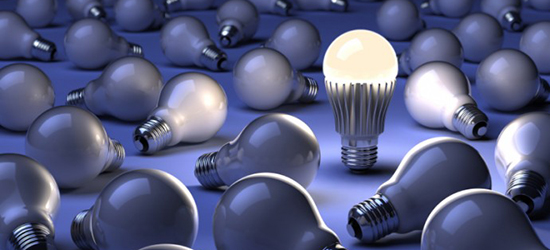LED Lighting Efficiency
LEDs, or Light Emitting Diodes, have been around for years, but only recently evolved to the point where they became useful as a lighting solution. Now, thanks to their high-quality light and energy efficiency, they are some of the most popular lights on the market.
How efficient are they?

LEDs use about 85% less electricity than incandescent bulbs and as much as 50% less than fluorescents. The amount saved with fluorescents will vary depending on whether you’re using a fluorescent tube or a compact fluorescent bulb (CFL). The efficiency of a light bulb is measured in lumens per watt and currently LED technology is providing higher lumens per watt than fluorescent, but is not practical for every application a fluorescent source is being used.
How do they save energy?
One of the main problems with incandescent bulbs is they emit a great deal of energy as heat (that’s why you can burn yourself if you touch a lit incandescent bulb), and this heat signifies that some energy is being wasted instead of converted to light.
On the other hand, if you touch an LED light it is typically cool to the touch and will likely not notice any heat at all. This is because more electricity is being converted to light — about 85% more.
A few of the major advantages of LEDs over CFLs are they don’t produce any UV rays, last 5 times longer, save 20% in energy costs and are lead and mercury free.
By design LEDs can last as much as 50 times longer than other bulbs and have lifetimes ranging from 30,000 to 100,000 hours or more at constant operation. Depending on how many hours a day your facility is lit, this can equal a lifespan of anywhere from 6 to 30 years. In comparison, incandescent bulbs only last an average of 1000 to 5000 hours, CFLs last 8,000 to 10,000 hours, and fluorescent tubes have lifetimes of 20,000 to 50,000 hours.
Part of the reason LEDs last so long is because they are durable (no glass components) and do not have a filament (like incandescent bulbs) that can break our burn out. Their illumination comes exclusively from the movement of electrons in a semiconductor material.
Upfront costs

Although LED prices have dropped dramatically, and continue to do so as technology advances, they typically cost more than other lighting systems. However, their high level of efficiency means you can recoup your upfront costs in a relatively short period of time. Besides requiring less electricity, LED’s long lifespan also saves you money on maintenance and replacement bulbs, and their eco-friendliness means you may be eligible for rebates and tax incentives (more ways to save).
Widespread Benefits
The U.S. Department of Energy sees LEDs as the lighting source with the greatest potential for the future. They predict that, with widespread adoption of LEDs, by 2025 the country will:
- Lower electricity demands for lighting by 62%.
- Reduce carbon emissions by 258 million metric tons.
- Diminish amount of materials in landfills.
- Prevent construction of 133 new power plants.
- Save $280 billion.
Although LEDs aren’t practical for every application (yet!), they are certainly the lighting choice of the future and offer huge benefits, including energy savings, for your facility and the country as a whole.



Doest the efficiency of a LED light depends upon the CRI(color rendering index) number?
Its really fascinating how LED lights tend to use about 85% less energy than incandescent bulbs and 50% less than fluorescent ones. The lightings in our house are starting to flicker so I think this is the right moment to look for replacements. There are a lot of styles so I have to choose wisely, and I also heard there are unique types too, like the candle bulbs.